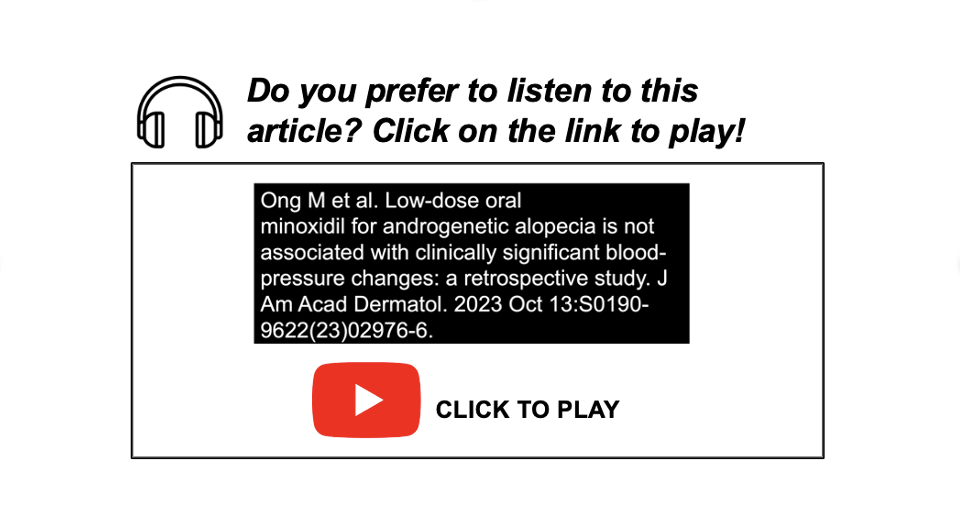Another Study Suggests LDOM Has Minimal Effects on Blood Pressure in Females and Males
Another Study Shows us that LDOM does not Change Blood Pressure Much.
Prior studies have examined the effects of blood pressure in patients with AGA.
We’ve reviewed two important studies in the past including studies in 2022 by Sanabria et al and Jimenez-Cauhe et al
In 2022, Sanabria et al performed a nice study in 34 men health males aged 21 to 58 years without cardiovascular problems. The group showed that a 5 mg pill in males changed systolic blood pressure by 3 mm Hg and diastolic by 2 mm Hg at a 24 weeks follow up time point.
In 2022, Jiminez-Cauhe et al performed blood pressure readings including mean systolic BP (mSBP), mean diastolic blood pressure (mDBP), and mean heart rate (mHR) at 2- and 4-hour intervals before and after the intake of 5 mg LDOM. The authors showed 1) There was no statistically significant differences were found between baseline and mean 24 hr LDOM measurements in mSBP, -mDBP, and -mHR. 2) 2 hours after the 5 mg dose, there was a non significant reduction in systolic BP (from 123.6 to 121.6, p = 0.45) 3) 2 hours after the 5 mg dose, there was a significant reduction in diastolic BP (from 76.7 to 71.9, p = 0.04) 4) 2 hours after the 5 mg dose, there was a non-significant reduction in heart rate (from 78.7 to 74.5, p = 0.07) 5) There were no significant differences at the 4 hour time point.
Ong et al 2023
Authors from Weill Cornell set out to examine blood pressure changes before and after low dose oral minoxidil use in patients with AGA.
There was a total of 151 patients in this study with 59% females and mean age 49 years (range 18–81). The median dose was 2.5-mg/day (range 0.625-5-mg/day). Interestingly, mean dose was similar between females and males (1.9-mg/day, 2.1-mg/day, respectively (p=0.32)). (This was surprising as females generally are treated with much lower doses than males). Blood pressures were measured, on average, 13 weeks before and 17 weeks after initiating minoxidil.
Results
All systolic blood pressures by age group and sex were similar before and after starting oral minoxidil treatment (all p>0.05). All diastolic blood pressure measurements by age and sex were similar before and after initiating minoxidil therapy, except for males ages 35–49 years, who had statistically though not clinically, significant decreases in diastolic blood pressure from 81 mmHg to 78 mmHg (p=0.03) No patient using low dose oral minoxidil experienced had clinical hypotension (defined as <90/60).
All in all, the authors found that low-dose oral minoxidil for AGA treatment was not associated with clinically significant systolic or diastolic BP changes in either sex or in any age group.
Comments.
This is an interesting study that again speak to the fact that LDOM does not change blood pressure in a significant way.
I think there are two things that always need to be included in studies of blood pressure with minoxidil and that is whether or not the drug causes heart palpitations and affects heart rate. It’s quite possible that LDOM does not change blood pressure readings all that much but does give some patients annoying palpitations that prompt a small number of patients to actually stop the drug.
Similarly, we are learning that LDOM does come with a tendency to raise heart rate a few beats and these numbers really need to be recorded as we continue our understanding of the long term effects of LDOM.
This study included a lot of female patients on quite high doses of oral minoxidil. At least half of the female patients were using 2.5 mg. The median dose was 2.5 mg and the mean dose was 1.9 mg.
It certainly is encouraging to know that mean systolic and diastolic blood pressure are not affected by these doses.
Again, what I am curious to know in a study like this is the proportion who had heart palpitations and what the mean heart rate may have done. With about 40 female patients in this study on 2.5 mg, one wonders how they all did in terms of palpitations and heart rate as well as other side effects like fluid retention, insomnia, weight gain, hypertrichosis. I see alot of problems with 2.5 mg doses in women so I’m not a great fan of this dose myself.
This was a study in blood pressure measurements and not efficacy or side effects so we’ll need to leave those issues for another study.
All in all, this study provides good evidence that blood pressure in women is not affected and blood pressure in males is generally not affected except in males 35 to 49 who had a very slight reduction in diastolic blood pressure by 3 mm Hg.
This study shows different results from the Sanabria et al study where oral minoxidil was found to cause a drop in both systolic and diastolic blood pressure in males. The dose in the Sanabria et al study was 5 mg and included only males. The mean dose of oral minoxidil in males here in the Ong et al study was 2.1 mg so it’s quite a bit less.
REFERENCE
Ong M et al. Low-dose oral minoxidil for androgenetic alopecia is not associated with clinically significant blood-pressure changes: a retrospective study. J Am Acad Dermatol. 2023 Oct 13:S0190-9622(23)02976-6. doi: 10.1016/j.jaad.2023.10.010. Online ahead of print.
Sanabria et al. Prospective cardiovascular evaluation with 24-h Holter and 24-h ambulatory blood pressure monitoring in men using 5 mg oral minoxidil for androgenetic alopecia. J Am Acad Dermatol . 2022 May 18;S0190-9622(22)00821-0.
Jimenez-Cauhe J et al. Before-after study with 24-hour ambulatory blood pressure monitoring after the first dose of 5 mg oral minoxidil .J Am Acad Dermatol. 2022 Dec;87(6):e235-e237. doi: 10.1016/j.jaad.2022.06.1205. Epub 2022 Aug 13.
This article was written by Dr. Jeff Donovan, a Canadian and US board certified dermatologist specializing exclusively in hair loss.



